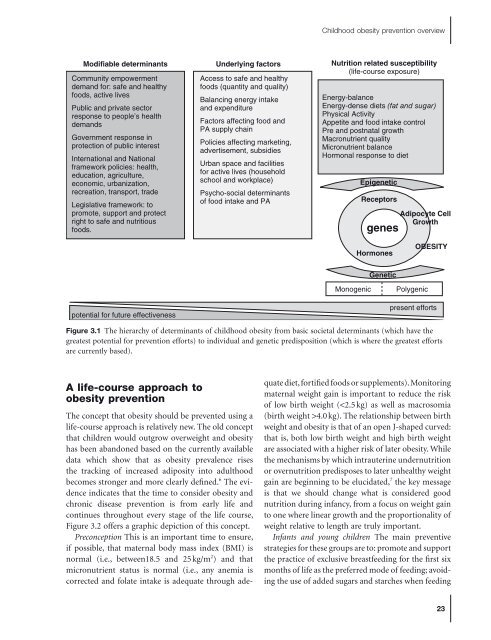Preventing Childhood Obesity - Evidence Policy and Practice.pdf
Preventing Childhood Obesity - Evidence Policy and Practice.pdf
Preventing Childhood Obesity - Evidence Policy and Practice.pdf
Create successful ePaper yourself
Turn your PDF publications into a flip-book with our unique Google optimized e-Paper software.
<strong>Childhood</strong> obesity prevention overview<br />
Modifiable determinants Underlying factors Nutrition related susceptibility<br />
(life-course exposure)<br />
Community empowerment<br />
dem<strong>and</strong> for: safe <strong>and</strong> healthy<br />
foods, active lives<br />
Public <strong>and</strong> private sector<br />
response to people’s health<br />
dem<strong>and</strong>s<br />
Government response in<br />
protection of public interest<br />
International <strong>and</strong> National<br />
framework policies: health,<br />
education, agriculture,<br />
economic, urbanization,<br />
recreation, transport, trade<br />
Legislative framework: to<br />
promote, support <strong>and</strong> protect<br />
right to safe <strong>and</strong> nutritious<br />
foods.<br />
Access to safe <strong>and</strong> healthy<br />
foods (quantity <strong>and</strong> quality)<br />
Balancing energy intake<br />
<strong>and</strong> expenditure<br />
Factors affecting food <strong>and</strong><br />
PA supply chain<br />
Policies affecting marketing,<br />
advertisement, subsidies<br />
Urban space <strong>and</strong> facilities<br />
for active lives (household<br />
school <strong>and</strong> workplace)<br />
Psycho-social determinants<br />
of food intake <strong>and</strong> PA<br />
Energy-balance<br />
Energy-dense diets (fat <strong>and</strong> sugar)<br />
Physical Activity<br />
Appetite <strong>and</strong> food intake control<br />
Pre <strong>and</strong> postnatal growth<br />
Macronutrient quality<br />
Micronutrient balance<br />
Hormonal response to diet<br />
Epigenetic<br />
Receptors<br />
Adipocyte Cell<br />
Growth<br />
genes<br />
Hormones<br />
OBESITY<br />
Genetic<br />
Monogenic<br />
Polygenic<br />
potential for future effectiveness<br />
present efforts<br />
Figure 3.1 The hierarchy of determinants of childhood obesity from basic societal determinants (which have the<br />
greatest potential for prevention efforts) to individual <strong>and</strong> genetic predisposition (which is where the greatest efforts<br />
are currently based).<br />
A l ife - c ourse a pproach to<br />
o besity p revention<br />
The concept that obesity should be prevented using a<br />
life - course approach is relatively new. The old concept<br />
that children would outgrow overweight <strong>and</strong> obesity<br />
has been ab<strong>and</strong>oned based on the currently available<br />
data which show that as obesity prevalence rises<br />
the tracking of increased adiposity into adulthood<br />
becomes stronger <strong>and</strong> more clearly defined. 6 The evidence<br />
indicates that the time to consider obesity <strong>and</strong><br />
chronic disease prevention is from early life <strong>and</strong><br />
continues throughout every stage of the life course,<br />
Figure 3.2 offers a graphic depiction of this concept.<br />
Preconception This is an important time to ensure,<br />
if possible, that maternal body mass index ( BMI ) is<br />
normal (i.e., between18.5 <strong>and</strong> 25 kg/m 2 ) <strong>and</strong> that<br />
micronutrient status is normal (i.e., any anemia is<br />
corrected <strong>and</strong> folate intake is adequate through ade-<br />
quate diet, fortified foods or supplements). Monitoring<br />
maternal weight gain is important to reduce the risk<br />
of low birth weight ( < 2.5 kg) as well as macrosomia<br />
(birth weight > 4.0 kg). The relationship between birth<br />
weight <strong>and</strong> obesity is that of an open J - shaped curved:<br />
that is, both low birth weight <strong>and</strong> high birth weight<br />
are associated with a higher risk of later obesity. While<br />
the mechanisms by which intrauterine undernutrition<br />
or overnutrition predisposes to later unhealthy weight<br />
gain are beginning to be elucidated, 7 the key message<br />
is that we should change what is considered good<br />
nutrition during infancy, from a focus on weight gain<br />
to one where linear growth <strong>and</strong> the proportionality of<br />
weight relative to length are truly important.<br />
Infants <strong>and</strong> young children The main preventive<br />
strategies for these groups are to: promote <strong>and</strong> support<br />
the practice of exclusive breastfeeding for the first six<br />
months of life as the preferred mode of feeding; avoiding<br />
the use of added sugars <strong>and</strong> starches when feeding<br />
23

















